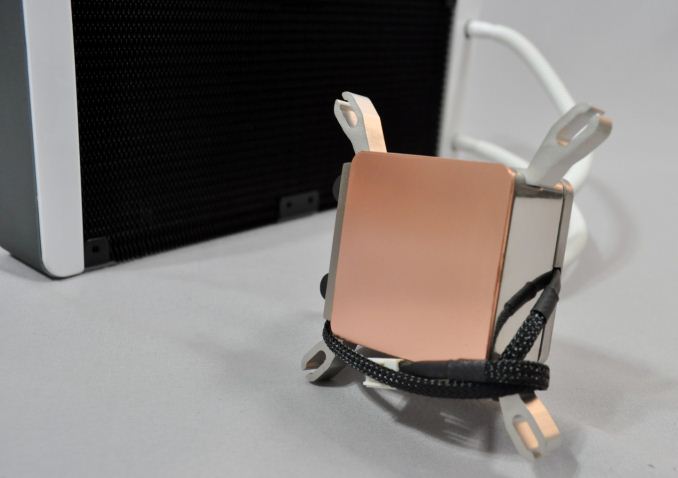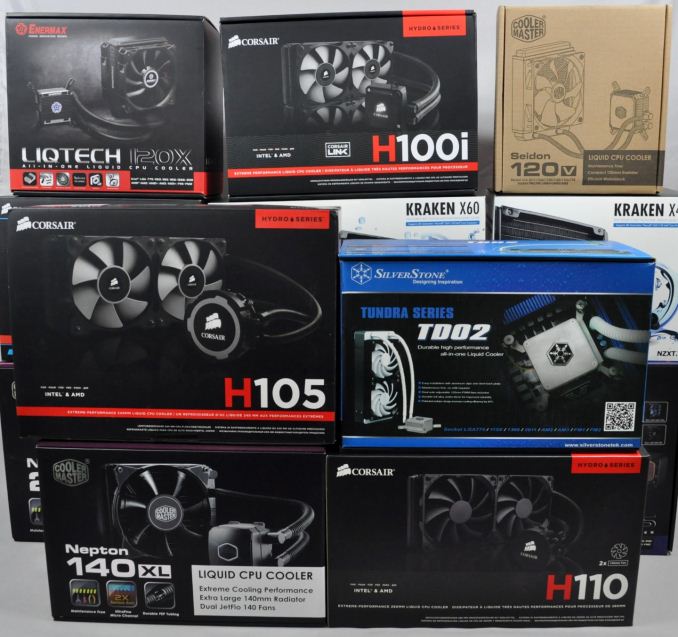Closed Loop AIO Liquid Coolers: 14-way Mega Roundup Review
by E. Fylladitakis on February 12, 2014 7:00 AM EST
Remember the time when liquid cooling a computer chip was considered to be an extreme approach, one performed by hardcore enthusiasts and overclockers alone? Everything had to be personally designed and or procured by the user, as there were no specialized commercial products available at the time. Radiators were modified heater cores extracted from cars, CPU blocks were rare and occasionally machined at local workshops using a copper block and a lathe, while high-performance tubing came from shops with medical supplies.
As demand grew, aided by the ever-increasing noise of small CPU heatsinks, companies specializing on liquid cooling solutions began turning up -- a little too fast perhaps, as tens of companies were founded within a few months' time and very few of them actually survived for more than a couple of years. Enthusiasts could then buy specialized liquid cooling equipment and even whole kits from just one seller and only had to assemble the setup into their system. That of course is no simple process for an amateur and a nightmare for a system builder, who cannot ship a system with a topped off water cooling tank or assume that the user has the skills required to maintain such a system, therefore the potential market remained limited to advanced users only.
This all changed in 2012, when Asetek came up with an inexpensive closed loop solution, a liquid cooling device that was leak-free and required no maintenance at all. The radiators of the first few solutions were small and their overall performance hardly better than that of air coolers; however, aided by the modernization of computer cases, the mounting of larger, thicker radiators inside a PC soon was not a problem. In many cases the kits were now no harder to install than any CPU cooler and required no maintenance at all, opening the market to virtually every computer user seeking a performance cooling solution. This spurred massive interest amongst OEMs and manufacturers, who all strive for a slice of the pie.
There have been tens of AIO (All-in-One) closed loop liquid coolers released just in 2013; today, we are having a roundup with 14 of them, coming from five different manufacturers, alphabetically listed in the table below.
| Product | Radiator Effective Surface | Radiator Thickness | # of Fans (Supplied / Maximum) | Speed Range of Supplied Fans (RPM) | Current Retail Pricing |
| Cooler Master Seidon 120V | 120mm × 120mm | 27mm | 1 / 2 | 600-2400 | $49.99 |
| Cooler Master Nepton 140XL | 140mm × 140mm | 38mm | 2 / 2 | 800-2000 | $99.99 |
| Cooler Master Nepton 280L | 140mm × 280mm | 30mm | 2 / 4 | 800-2000 | $119.99 |
| Corsair H75 | 120mm × 120mm | 25mm | 2 / 2 | 800-2000 | $69.99 |
| Corsair H90 | 140mm × 140mm | 27mm | 1 / 2 | 600-1500 | $84.99 |
| Corsair H100i | 120mm × 240mm | 27mm | 2 / 4 | 800-2700 | $109.99 |
| Corsair H105 | 120mm × 240mm | 38mm | 2 / 4 | 800- 2700 | $119.99 |
| Corsair H110 | 140mm × 280mm | 29mm | 2 / 4 | 600-1500 | $126.99 |
| Enermax Liqmax 120S | 120mm × 120mm | 32mm | 1 / 2 |
600-1300 600-2000 600-2500 (Multi-range) |
$163.00* |
| Enermax Liqtech 120X | 120mm × 120mm | 43mm | 2 / 2 |
600-1300 600-2000 600-2500 (Multi-range) |
$171.10* |
| NZXT Kraken X40 | 140mm × 140mm | 27mm | 1 / 2 | 800-2000 | $89.99 |
| NZXT Kraken X60 | 140mm × 280mm | 27mm | 2 / 4 | 800-2000 | $119.99 |
| Silverstone Tundra TD02 | 120mm × 240mm | 45mm | 2 / 4 | 1500-2500 | $118.99 |
| Silverstone Tundra TD03 | 120mm × 120mm | 45mm | 2 / 2 | 1500-2500 | $97.99 |
*The coolers from Enermax are not widely available in the USA at the time of this review, with the only viable option appearing to be that of import from Asia or Europe.
Although Asetek was the first to come up with the design and they hold patents for it, they are not the only OEM of AIO cooling solutions today. At least three different OEMs are behind the kits listed in the table above. We will have a closer look at each one of them in the following pages.











139 Comments
View All Comments
jmke - Wednesday, February 12, 2014 - link
as with everything, the noise scale and extreme focus of SPCR does give a slightly twisted view.none of these AIO would qualify as silent, anything above 30dBA would be loud for him; his kitchen is <30dBA... ;-)
EnzoFX - Wednesday, February 12, 2014 - link
>30DB is loud lol. At least audible to anyone I would say, so can't we at least say it's not silent? Furthermore he'd provide at least a vast array of reference points, where Anandtech is severely lacking when it comes to cooling/cases/etc.E.Fyll - Wednesday, February 12, 2014 - link
Definitely not loud and not even audible to most. 30 dB(A) is the lowermost threshold that the vast majority of sound level meters can take a reading from. I have provided a thorough explanation about this down below in the comments. I personally consider any test that I have seen stating that they got a valid reading below 30 dB(A) with sub - $30k equipment to be rubbish.Jon-R - Wednesday, February 12, 2014 - link
So you're saying that the tests over at SilentPCReview are rubbish? What sound measurement equipment did you use? I couldn't find a mention of it.JlHADJOE - Thursday, February 13, 2014 - link
30 dB is very quiet far as background noise goes.Whisper Quiet Library at 6' 30dB
Sauce: http://www.gcaudio.com/resources/howtos/loudness.h...
JlHADJOE - Friday, February 14, 2014 - link
It's not so much that their tests are rubbish, just unrealistic.SilentPC tests in an anechoic chamber, so the noise floor when they test is near zero. Compared to that, an increase to 30dBA is very loud. But in a real-world environment, 30dBA is whisper quiet.
I do agree though that use of the anechoic chamber keeps their tests consistent and repeatable. Just not necessarily representative of what a case will actually sound like in a real room.
YazX_ - Wednesday, February 12, 2014 - link
Thx for this thorough review, i have corsair H100i, its awesome AIO cooler, but the fans are piece of shit and very noisy, i replaced them with Bitfenix LED ones, although they operate at 1800 RPM, but i never had to see them operate on that speed, my CPU is OCed to 4.5Ghz and max temp is 65, so they work 50% most of the time and pretty silent.AshyPistachios - Wednesday, February 12, 2014 - link
This ended up comparing fans more than it did rads/pumps. I would like to see a test scenario where identical fans are used on each rad. The current testing methodology does test the complete package, but people seeking silent setups tend to swap all of the fans anywayMrSpadge - Wednesday, February 12, 2014 - link
Agreed - comparing performance doesn't mean much with such different fan noise levels. You could use some high pressure fans for all systems, for example.And I couldn't care less if a stock fan runs at 7 V or what ever. What I do care about is the noise. In practice I set my rigs up for the best cooling I can get at subjectively low noise level (they're running 24/7 under load). So pick any reasonably quiet noise level, set the fans to whatever speed is required to get there and then compare performance (note: this is even more meaningful if you use similar fans). With PWM you're not limited to 12V and 7V, it's not 2005 any more.
E.Fyll - Wednesday, February 12, 2014 - link
7 Volts is about the same voltage level as most modern motherboard apply in their "quiet" mode. High enough to start nearly all fans ever made, low enough to keep things quiet. Unfortunately, I cannot perform testing the way you propose. As you mentioned yourself, it would have to be a "subjectively low" noise level. The very word "subjectively" puts me off. Even if I do set such a noise limit, which would be terribly wrong as it would just be based on my subjective opinion, not all coolers would be able to operate as such a noise level at all.It is even less meaningful to use the same fans; when you are buying a kit, you are buying the kit with its fans. Purchasing additional fans not only raises its cost but, depending on the characteristic behavior of the fan, the fan itself can affect performance and favor some kits over others. The actual performance of a fan is not based on its RPM or CFM ratings, it is a very complicated matter. That would render any comparisons between different kits virtually useless. Furthermore, the choice of fans would be based on my subjective opinion as well, nobody warranties that the end user will be purchasing the same fans out of the hundreds of possible choices. Someone would want me to use a quieter fan, others might want something more powerful, others something cheaper, others something fancier and so on. And of course, most would just want to buy a kit and be done with it. The only objective comparison is to compare the performance of a kit with its stock fans, as it comes supplied from the factory. Everything else is based on assumptions and subjective opinions that, including mine, have no place in an objective review.